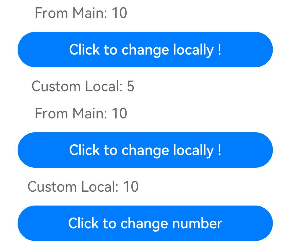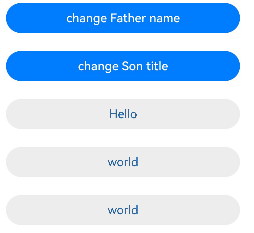# \@Prop装饰器:父子单向同步
\@Prop装饰的变量可以和父组件建立单向的同步关系。\@Prop装饰的变量是可变的,但是变化不会同步回其父组件。
在阅读\@Prop文档前,建议开发者首先了解[\@State](./arkts-state.md)的基本用法。
> **说明:**
>
> 从API version 9开始,该装饰器支持在ArkTS卡片中使用。
>
> 从API version 11开始,该装饰器支持在原子化服务中使用。
## 概述
\@Prop装饰的变量和父组件建立单向的同步关系:
- \@Prop变量允许在本地修改,但修改后的变化不会同步回父组件。
- 当数据源更改时,\@Prop装饰的变量都会更新,并且会覆盖本地所有更改。因此,数值的同步是父组件到子组件(所属组件),子组件数值的变化不会同步到父组件。
## 限制条件
- \@Prop装饰变量时会进行深拷贝,在拷贝的过程中除了基本类型、Map、Set、Date、Array外,都会丢失类型。例如[PixelMap](../reference/apis-image-kit/js-apis-image.md#pixelmap7)等通过NAPI提供的复杂类型,由于有部分实现在Native侧,因此无法在ArkTS侧通过深拷贝获得完整的数据。
- \@Prop装饰器不能在\@Entry装饰的自定义组件中使用。
## 装饰器使用规则说明
| \@Prop变量装饰器 | 说明 |
| ----------- | ---------------------------------------- |
| 装饰器参数 | 无 |
| 同步类型 | 单向同步:对父组件状态变量值的修改,将同步给子组件\@Prop装饰的变量,子组件\@Prop变量的修改不会同步到父组件的状态变量上。嵌套类型的场景请参考[观察变化](#观察变化)。 |
| 允许装饰的变量类型 | Object、class、string、number、boolean、enum类型,以及这些类型的数组。
不支持any,支持undefined和null。
支持Date类型。
API11及以上支持Map、Set类型。
支持ArkUI框架定义的联合类型Length、ResourceStr、ResourceColor类型。
必须指定类型。
\@Prop和[数据源](arkts-state-management-overview.md#基本概念)类型需要相同,有以下三种情况:
- \@Prop装饰的变量和\@State以及其他装饰器同步时双方的类型必须相同,示例请参考[父组件@State到子组件@Prop简单数据类型同步](#父组件state到子组件prop简单数据类型同步)。
- \@Prop装饰的变量和\@State以及其他装饰器装饰的数组的项同步时 ,\@Prop的类型需要和\@State装饰的数组的数组项相同,比如\@Prop : T和\@State : Array<T>,示例请参考[父组件@State数组中的项到子组件@Prop简单数据类型同步](#父组件state数组项到子组件prop简单数据类型同步)。
- 当父组件状态变量为Object或者class时,\@Prop装饰的变量和父组件状态变量的属性类型相同,示例请参考[从父组件中的@State类对象属性到@Prop简单类型的同步](#从父组件中的state类对象属性到prop简单类型的同步)。
支持类型的场景请参考[观察变化](#观察变化)。
API11及以上支持上述支持类型的联合类型,比如string \| number, string \| undefined 或者 ClassA \| null,示例见[Prop支持联合类型实例](#prop支持联合类型实例)。
**注意**
当使用undefined和null的时候,建议显式指定类型,遵循TypeScript类型校验,比如:`@Prop a : string \| undefined = undefined`是推荐的,不推荐`@Prop a: string = undefined`。 |
| 嵌套传递层数 | 在组件复用场景,建议@Prop深度嵌套数据不要超过5层,嵌套太多会导致深拷贝占用的空间过大以及GarbageCollection(垃圾回收),引起性能问题,此时更建议使用[\@ObjectLink](arkts-observed-and-objectlink.md)。 |
| 被装饰变量的初始值 | 允许本地初始化。如果在API 11中和[\@Require](arkts-require.md)结合使用,则必须父组件构造传参。 |
## 变量的传递/访问规则说明
| 传递/访问 | 说明 |
| ------------------ | ------------------------------------------------------------ |
| 从父组件初始化 | 如果本地有初始化,则是可选的,初始化行为和[\@State](./arkts-state.md#变量的传递访问规则说明)保持一致。没有的话,则必选,支持父组件中的常规变量(常规变量对@Prop赋值,只是数值的初始化,常规变量的变化不会触发UI刷新。只有状态变量才能触发UI刷新)、[\@State](arkts-state.md)、[\@Link](arkts-link.md)、\@Prop、[\@Provide](arkts-provide-and-consume.md)、[\@Consume](arkts-provide-and-consume.md)、[\@ObjectLink](arkts-observed-and-objectlink.md)、[\@StorageLink](arkts-appstorage.md#storagelink)、[\@StorageProp](arkts-appstorage.md#storageprop)、[\@LocalStorageLink](arkts-localstorage.md#localstoragelink)和[\@LocalStorageProp](arkts-localstorage.md#localstorageprop)去初始化子组件中的\@Prop变量。 |
| 用于初始化子组件 | \@Prop支持去初始化子组件中的常规变量、\@State、\@Link、\@Prop、\@Provide。 |
| 是否支持组件外访问 | \@Prop装饰的变量是私有的,只能在组件内访问。 |
**图1** 初始化规则图示

## 观察变化和行为表现
### 观察变化
\@Prop装饰的数据可以观察到以下变化。
- 当装饰的类型是允许的类型,即Object、class、string、number、boolean、enum类型都可以观察到赋值的变化。
```ts
// 简单类型
@Prop count: number;
// 赋值的变化可以被观察到
this.count = 1;
// 复杂类型
@Prop title: Model;
// 可以观察到赋值的变化
this.title = new Model('Hi');
```
- 当装饰的类型是Object或者class复杂类型时,可以观察到第一层的属性的变化,属性即Object.keys(observedObject)返回的所有属性;
```ts
class Info {
public value: string;
constructor(value: string) {
this.value = value;
}
}
class Model {
public value: string;
public info: Info;
constructor(value: string, info: Info) {
this.value = value;
this.info = info;
}
}
@Prop title: Model;
// 可以观察到第一层的变化
this.title.value = 'Hi';
// 观察不到第二层的变化
this.title.info.value = 'ArkUI';
```
对于嵌套场景,如果class是被\@Observed装饰的,可以观察到class属性的变化,示例请参考[@Prop嵌套场景](#prop嵌套场景)。
- 当装饰的类型是数组的时候,可以观察到数组本身的赋值和数组项的添加、删除和更新。
```ts
// @State装饰的对象为数组时
@Prop title: string[];
// 数组自身的赋值可以观察到
this.title = ['1'];
// 数组项的赋值可以观察到
this.title[0] = '2';
// 删除数组项可以观察到
this.title.pop();
// 新增数组项可以观察到
this.title.push('3');
```
对于\@State和\@Prop的同步场景:
- 使用父组件中\@State变量的值初始化子组件中的\@Prop变量。当\@State变量变化时,该变量值也会同步更新至\@Prop变量。
- \@Prop装饰的变量的修改不会影响其数据源\@State装饰变量的值。
- 除了\@State,数据源也可以用\@Link或\@Prop装饰,对\@Prop的同步机制是相同的。
- 数据源和\@Prop变量的类型需要相同,\@Prop允许简单类型和class类型。
- 当装饰的对象是Date时,可以观察到Date整体的赋值,同时可通过调用Date的接口`setFullYear`, `setMonth`, `setDate`, `setHours`, `setMinutes`, `setSeconds`, `setMilliseconds`, `setTime`, `setUTCFullYear`, `setUTCMonth`, `setUTCDate`, `setUTCHours`, `setUTCMinutes`, `setUTCSeconds`, `setUTCMilliseconds` 更新Date的属性。
```ts
@Component
struct DateComponent {
@Prop selectedDate: Date = new Date('');
build() {
Column() {
Button('child update the new date')
.margin(10)
.onClick(() => {
this.selectedDate = new Date('2023-09-09');
})
Button(`child increase the year by 1`).onClick(() => {
this.selectedDate.setFullYear(this.selectedDate.getFullYear() + 1);
})
DatePicker({
start: new Date('1970-1-1'),
end: new Date('2100-1-1'),
selected: this.selectedDate
})
}
}
}
@Entry
@Component
struct ParentComponent {
@State parentSelectedDate: Date = new Date('2021-08-08');
build() {
Column() {
Button('parent update the new date')
.margin(10)
.onClick(() => {
this.parentSelectedDate = new Date('2023-07-07');
})
Button('parent increase the day by 1')
.margin(10)
.onClick(() => {
this.parentSelectedDate.setDate(this.parentSelectedDate.getDate() + 1);
})
DatePicker({
start: new Date('1970-1-1'),
end: new Date('2100-1-1'),
selected: this.parentSelectedDate
})
DateComponent({ selectedDate: this.parentSelectedDate })
}
}
}
```
- 当装饰的变量是Map时,可以观察到Map整体的赋值,同时可通过调用Map的接口`set`, `clear`, `delete` 更新Map的值。详见[装饰Map类型变量](#装饰map类型变量)。
- 当装饰的变量是Set时,可以观察到Set整体的赋值,同时可通过调用Set的接口`add`, `clear`, `delete` 更新Set的值。详见[装饰Set类型变量](#装饰set类型变量)。
### 框架行为
要理解\@Prop变量值初始化和更新机制,有必要了解父组件和拥有\@Prop变量的子组件初始渲染和更新流程。
1. 初始渲染:
1. 执行父组件的build()函数将创建子组件的新实例,将数据源传递给子组件;
2. 初始化子组件\@Prop装饰的变量。
2. 更新:
1. 子组件\@Prop更新时,更新仅停留在当前子组件,不会同步回父组件;
2. 当父组件的数据源更新时,子组件的\@Prop装饰的变量将被来自父组件的数据源重置,所有\@Prop装饰的本地的修改将被父组件的更新覆盖。
> **说明:**
>
> \@Prop装饰的数据更新依赖其所属自定义组件的重新渲染,所以在应用进入后台后,\@Prop无法刷新,推荐使用\@Link代替。
## 使用场景
### 父组件\@State到子组件\@Prop简单数据类型同步
以下示例是\@State到子组件\@Prop简单数据同步,父组件ParentComponent的状态变量countDownStartValue初始化子组件CountDownComponent中\@Prop装饰的count,点击“Try again”,count的修改仅保留在CountDownComponent 不会同步给父组件ParentComponent。
ParentComponent的状态变量countDownStartValue的变化将重置CountDownComponent的count。
```ts
@Component
struct CountDownComponent {
@Prop count: number = 0;
costOfOneAttempt: number = 1;
build() {
Column() {
if (this.count > 0) {
Text(`You have ${this.count} Nuggets left`)
} else {
Text('Game over!')
}
// @Prop装饰的变量不会同步给父组件
Button(`Try again`).onClick(() => {
this.count -= this.costOfOneAttempt;
})
}
}
}
@Entry
@Component
struct ParentComponent {
@State countDownStartValue: number = 10;
build() {
Column() {
Text(`Grant ${this.countDownStartValue} nuggets to play.`)
// 父组件的数据源的修改会同步给子组件
Button(`+1 - Nuggets in New Game`).onClick(() => {
this.countDownStartValue += 1;
})
// 父组件的修改会同步给子组件
Button(`-1 - Nuggets in New Game`).onClick(() => {
this.countDownStartValue -= 1;
})
CountDownComponent({ count: this.countDownStartValue, costOfOneAttempt: 2 })
}
}
}
```
在上面的示例中:
1. CountDownComponent子组件首次创建时其\@Prop装饰的count变量将从父组件\@State装饰的countDownStartValue变量初始化;
2. 按“+1”或“-1”按钮时,父组件的\@State装饰的countDownStartValue值会变化,这将触发父组件重新渲染,在父组件重新渲染过程中会刷新使用countDownStartValue状态变量的UI组件并单向同步更新CountDownComponent子组件中的count值;
3. 更新count状态变量值也会触发CountDownComponent的重新渲染,在重新渲染过程中,评估使用count状态变量的if语句条件(this.count > 0),并执行true分支中的使用count状态变量的UI组件相关描述来更新Text组件的UI显示;
4. 当按下子组件CountDownComponent的“Try again”按钮时,其\@Prop变量count将被更改,但是count值的更改不会影响父组件的countDownStartValue值;
5. 父组件的countDownStartValue值会变化时,父组件的修改将覆盖掉子组件CountDownComponent中count本地的修改。
### 父组件\@State数组项到子组件\@Prop简单数据类型同步
父组件中\@State如果装饰的数组,其数组项也可以初始化\@Prop。以下示例中父组件Index中\@State装饰的数组arr,将其数组项初始化子组件Child中\@Prop装饰的value。
```ts
@Component
struct Child {
@Prop value: number = 0;
build() {
Text(`${this.value}`)
.fontSize(50)
.onClick(() => {
this.value++;
})
}
}
@Entry
@Component
struct Index {
@State arr: number[] = [1, 2, 3];
build() {
Row() {
Column() {
Child({ value: this.arr[0] })
Child({ value: this.arr[1] })
Child({ value: this.arr[2] })
Divider().height(5)
ForEach(this.arr,
(item: number) => {
Child({ value: item })
},
(item: number) => item.toString()
)
Text('replace entire arr')
.fontSize(50)
.onClick(() => {
// 两个数组都包含项“3”。
this.arr = this.arr[0] == 1 ? [3, 4, 5] : [1, 2, 3];
})
}
}
}
}
```
初始渲染创建6个子组件实例,每个\@Prop装饰的变量初始化都在本地拷贝了一份数组项。子组件onclick事件处理程序会更改局部变量值。
如果点击界面上的“1”六下,“2”五下、“3”四下,将所有变量的本地取值都变为“7”。
```
7
7
7
----
7
7
7
```
单击replace entire arr后,屏幕将显示以下信息。
```
3
4
5
----
7
4
5
```
- 在子组件Child中做的所有的修改都不会同步回父组件Index组件,所以即使6个组件显示都为7,但在父组件Index中,this.arr保存的值依旧是[1,2,3]。
- 点击replace entire arr,this.arr[0] == 1成立,将this.arr赋值为[3, 4, 5];
- 因为this.arr[0]已更改,Child({value: this.arr[0]})组件将this.arr[0]更新同步到实例\@Prop装饰的变量。Child({value: this.arr[1]})和Child({value: this.arr[2]})的情况也类似。
- this.arr的更改触发ForEach更新,this.arr更新的前后都有数值为3的数组项:[3, 4, 5] 和[1, 2, 3]。根据diff算法,数组项“3”将被保留,删除“1”和“2”的数组项,添加为“4”和“5”的数组项。这就意味着,数组项“3”的组件不会重新生成,而是将其移动到第一位。所以“3”对应的组件不会更新,此时“3”对应的组件数值为“7”,ForEach最终的渲染结果是“7”,“4”,“5”。
### 从父组件中的\@State类对象属性到\@Prop简单类型的同步
如果图书馆有一本图书和两位用户,每位用户都可以将图书标记为已读,此标记行为不会影响其它读者用户。从代码角度讲,对\@Prop图书对象的本地更改不会同步给图书馆组件中的\@State图书对象。
在此示例中,图书类可以使用\@Observed装饰器,但不是必须的,只有在嵌套结构时需要此装饰器。这一点我们会在[从父组件中的@State数组项到@Prop class类型的同步](#从父组件中的state数组项到prop-class类型的同步)说明。
```ts
class Book {
public title: string;
public pages: number;
public readIt: boolean = false;
constructor(title: string, pages: number) {
this.title = title;
this.pages = pages;
}
}
@Component
struct ReaderComp {
@Prop book: Book = new Book("", 0);
build() {
Row() {
Text(this.book.title)
Text(`...has${this.book.pages} pages!`)
Text(`...${this.book.readIt ? "I have read" : 'I have not read it'}`)
.onClick(() => this.book.readIt = true)
}
}
}
@Entry
@Component
struct Library {
@State book: Book = new Book('100 secrets of C++', 765);
build() {
Column() {
ReaderComp({ book: this.book })
ReaderComp({ book: this.book })
}
}
}
```
### 从父组件中的\@State数组项到\@Prop class类型的同步
在下面的示例中,更改了\@State 装饰的allBooks数组中Book对象上的属性,但点击“Mark read for everyone”无反应。这是因为该属性是第二层的嵌套属性,\@State装饰器只能观察到第一层属性,不会观察到此属性更改,所以框架不会更新ReaderComp。
```ts
let nextId: number = 1;
// @Observed
class Book {
public id: number;
public title: string;
public pages: number;
public readIt: boolean = false;
constructor(title: string, pages: number) {
this.id = nextId++;
this.title = title;
this.pages = pages;
}
}
@Component
struct ReaderComp {
@Prop book: Book = new Book("", 1);
build() {
Row() {
Text(` ${this.book ? this.book.title : "Book is undefined"}`).fontColor('#e6000000')
Text(` has ${this.book ? this.book.pages : "Book is undefined"} pages!`).fontColor('#e6000000')
Text(` ${this.book ? this.book.readIt ? "I have read" : 'I have not read it' : "Book is undefined"}`).fontColor('#e6000000')
.onClick(() => this.book.readIt = true)
}
}
}
@Entry
@Component
struct Library {
@State allBooks: Book[] = [new Book("C#", 765), new Book("JS", 652), new Book("TS", 765)];
build() {
Column() {
Text('library`s all time favorite')
.width(312)
.height(40)
.backgroundColor('#0d000000')
.borderRadius(20)
.margin(12)
.padding({ left: 20 })
.fontColor('#e6000000')
ReaderComp({ book: this.allBooks[2] })
.backgroundColor('#0d000000')
.width(312)
.height(40)
.padding({ left: 20, top: 10 })
.borderRadius(20)
.colorBlend('#e6000000')
Divider()
Text('Books on loan to a reader')
.width(312)
.height(40)
.backgroundColor('#0d000000')
.borderRadius(20)
.margin(12)
.padding({ left: 20 })
.fontColor('#e6000000')
ForEach(this.allBooks, (book: Book) => {
ReaderComp({ book: book })
.margin(12)
.width(312)
.height(40)
.padding({ left: 20, top: 10 })
.backgroundColor('#0d000000')
.borderRadius(20)
},
(book: Book) => book.id.toString())
Button('Add new')
.width(312)
.height(40)
.margin(12)
.fontColor('#FFFFFF 90%')
.onClick(() => {
this.allBooks.push(new Book("JA", 512));
})
Button('Remove first book')
.width(312)
.height(40)
.margin(12)
.fontColor('#FFFFFF 90%')
.onClick(() => {
if (this.allBooks.length > 0){
this.allBooks.shift();
} else {
console.log("length <= 0");
}
})
Button("Mark read for everyone")
.width(312)
.height(40)
.margin(12)
.fontColor('#FFFFFF 90%')
.onClick(() => {
this.allBooks.forEach((book) => book.readIt = true)
})
}
}
}
```
需要使用\@Observed装饰class Book,Book的属性将被观察。 需要注意的是,\@Prop在子组件装饰的状态变量和父组件的数据源是单向同步关系,即ReaderComp中的\@Prop book的修改不会同步给父组件Library。而父组件只会在数值有更新的时候(和上一次状态的对比),才会触发UI的重新渲染。
```ts
@Observed
class Book {
public id: number;
public title: string;
public pages: number;
public readIt: boolean = false;
constructor(title: string, pages: number) {
this.id = nextId++;
this.title = title;
this.pages = pages;
}
}
```
\@Observed装饰的类的实例会被不透明的代理对象包装,此代理可以检测到包装对象内的所有属性更改。如果发生这种情况,此时,代理通知\@Prop,\@Prop对象值被更新。

### \@Prop本地初始化不和父组件同步
为了支持\@Component装饰的组件复用场景,\@Prop支持本地初始化,这样可以让\@Prop是否与父组件建立同步关系变得可选。当且仅当\@Prop有本地初始化时,从父组件向子组件传递\@Prop的数据源才是可选的。
下面的示例中,子组件包含两个\@Prop变量:
- \@Prop customCounter没有本地初始化,所以需要父组件提供数据源去初始化\@Prop,并当父组件的数据源变化时,\@Prop也将被更新;
- \@Prop customCounter2有本地初始化,在这种情况下,\@Prop依旧允许但非强制父组件同步数据源给\@Prop。
```ts
@Component
struct MyComponent {
@Prop customCounter: number;
@Prop customCounter2: number = 5;
build() {
Column() {
Row() {
Text(`From Main: ${this.customCounter}`).fontColor('#ff6b6565').margin({ left: -110, top: 12 })
}
Row() {
Button('Click to change locally !')
.width(288)
.height(40)
.margin({ left: 30, top: 12 })
.fontColor('#FFFFFF,90%')
.onClick(() => {
this.customCounter2++;
})
}
Row() {
Text(`Custom Local: ${this.customCounter2}`).fontColor('#ff6b6565').margin({ left: -110, top: 12 })
}
}
}
}
@Entry
@Component
struct MainProgram {
@State mainCounter: number = 10;
build() {
Column() {
Row() {
Column() {
// customCounter必须从父组件初始化,因为MyComponent的customCounter成员变量缺少本地初始化;此处,customCounter2可以不做初始化。
MyComponent({ customCounter: this.mainCounter })
// customCounter2也可以从父组件初始化,父组件初始化的值会覆盖子组件customCounter2的本地初始化的值
MyComponent({ customCounter: this.mainCounter, customCounter2: this.mainCounter })
}
}
Row() {
Column() {
Button('Click to change number')
.width(288)
.height(40)
.margin({ left: 30, top: 12 })
.fontColor('#FFFFFF,90%')
.onClick(() => {
this.mainCounter++;
})
}
}
}
}
}
```

### \@Prop嵌套场景
在嵌套场景下,每一层都要用@Observed装饰,且每一层都要被@Prop接收,这样才能观察到嵌套场景。
```ts
// 以下是嵌套类对象的数据结构。
@Observed
class Son {
public title: string;
constructor(title: string) {
this.title = title;
}
}
@Observed
class Father {
public name: string;
public son: Son;
constructor(name: string, son: Son) {
this.name = name;
this.son = son;
}
}
```
以下组件层次结构呈现的是@Prop嵌套场景的数据结构。
```ts
@Entry
@Component
struct Person {
@State person: Father = new Father('Hello', new Son('world'));
build() {
Column() {
Flex({ direction: FlexDirection.Column, alignItems: ItemAlign.Center }) {
Button('change Father name')
.width(312)
.height(40)
.margin(12)
.fontColor('#FFFFFF,90%')
.onClick(() => {
this.person.name = "Hi";
})
Button('change Son title')
.width(312)
.height(40)
.margin(12)
.fontColor('#FFFFFF,90%')
.onClick(() => {
this.person.son.title = "ArkUI";
})
Text(this.person.name)
.fontSize(16)
.margin(12)
.width(312)
.height(40)
.backgroundColor('#ededed')
.borderRadius(20)
.textAlign(TextAlign.Center)
.fontColor('#e6000000')
.onClick(() => {
this.person.name = 'Bye';
})
Text(this.person.son.title)
.fontSize(16)
.margin(12)
.width(312)
.height(40)
.backgroundColor('#ededed')
.borderRadius(20)
.textAlign(TextAlign.Center)
.onClick(() => {
this.person.son.title = "openHarmony";
})
Child({ child: this.person.son })
}
}
}
}
@Component
struct Child {
@Prop child: Son = new Son('');
build() {
Column() {
Text(this.child.title)
.fontSize(16)
.margin(12)
.width(312)
.height(40)
.backgroundColor('#ededed')
.borderRadius(20)
.textAlign(TextAlign.Center)
.onClick(() => {
this.child.title = 'Bye Bye';
})
}
}
}
```

### 装饰Map类型变量
> **说明:**
>
> 从API version 11开始,\@Prop支持Map类型。
在下面的示例中,value类型为Map\,点击Button改变message的值,视图会随之刷新。
```ts
@Component
struct Child {
@Prop value: Map = new Map([[0, "a"], [1, "b"], [3, "c"]]);
build() {
Column() {
ForEach(Array.from(this.value.entries()), (item: [number, string]) => {
Text(`${item[0]}`).fontSize(30)
Text(`${item[1]}`).fontSize(30)
Divider()
})
Button('child init map').onClick(() => {
this.value = new Map([[0, "a"], [1, "b"], [3, "c"]]);
})
Button('child set new one').onClick(() => {
this.value.set(4, "d");
})
Button('child clear').onClick(() => {
this.value.clear();
})
Button('child replace the first one').onClick(() => {
this.value.set(0, "aa");
})
Button('child delete the first one').onClick(() => {
this.value.delete(0);
})
}
}
}
@Entry
@Component
struct MapSample {
@State message: Map = new Map([[0, "a"], [1, "b"], [3, "c"]]);
build() {
Row() {
Column() {
Child({ value: this.message })
}
.width('100%')
}
.height('100%')
}
}
```
### 装饰Set类型变量
> **说明:**
>
> 从API version 11开始,\@Prop支持Set类型。
在下面的示例中,message类型为Set\,点击Button改变message的值,视图会随之刷新。
```ts
@Component
struct Child {
@Prop message: Set = new Set([0, 1, 2, 3, 4]);
build() {
Column() {
ForEach(Array.from(this.message.entries()), (item: [number, string]) => {
Text(`${item[0]}`).fontSize(30)
Divider()
})
Button('init set').onClick(() => {
this.message = new Set([0, 1, 2, 3, 4]);
})
Button('set new one').onClick(() => {
this.message.add(5);
})
Button('clear').onClick(() => {
this.message.clear();
})
Button('delete the first one').onClick(() => {
this.message.delete(0);
})
}
.width('100%')
}
}
@Entry
@Component
struct SetSample {
@State message: Set = new Set([0, 1, 2, 3, 4]);
build() {
Row() {
Column() {
Child({ message: this.message })
}
.width('100%')
}
.height('100%')
}
}
```
## Prop支持联合类型实例
@Prop支持联合类型和undefined和null,在下面的示例中,animal类型为Animals | undefined,点击父组件Zoo中的Button改变animal的属性或者类型,Child中也会对应刷新。
```ts
class Animals {
public name: string;
constructor(name: string) {
this.name = name;
}
}
@Component
struct Child {
@Prop animal: Animals | undefined;
build() {
Column() {
Text(`Child's animal is ${this.animal instanceof Animals ? this.animal.name : 'undefined'}`).fontSize(30)
Button('Child change animals into tigers')
.onClick(() => {
// 赋值为Animals的实例
this.animal = new Animals("Tiger");
})
Button('Child change animal to undefined')
.onClick(() => {
// 赋值为undefined
this.animal = undefined;
})
}.width('100%')
}
}
@Entry
@Component
struct Zoo {
@State animal: Animals | undefined = new Animals("lion");
build() {
Column() {
Text(`Parents' animals are ${this.animal instanceof Animals ? this.animal.name : 'undefined'}`).fontSize(30)
Child({animal: this.animal})
Button('Parents change animals into dogs')
.onClick(() => {
// 判断animal的类型,做属性的更新
if (this.animal instanceof Animals) {
this.animal.name = "Dog";
} else {
console.info('num is undefined, cannot change property');
}
})
Button('Parents change animal to undefined')
.onClick(() => {
// 赋值为undefined
this.animal = undefined;
})
}
}
}
```
## 常见问题
### \@Prop装饰状态变量未初始化错误
\@Prop需要被初始化,如果没有进行本地初始化的,则必须通过父组件进行初始化。如果进行了本地初始化,那么是可以不通过父组件进行初始化的。
【反例】
```ts
@Observed
class Commodity {
public price: number = 0;
constructor(price: number) {
this.price = price;
}
}
@Component
struct PropChild {
@Prop fruit: Commodity; // 未进行本地初始化
build() {
Text(`PropChild fruit ${this.fruit.price}`)
.onClick(() => {
this.fruit.price += 1;
})
}
}
@Entry
@Component
struct Parent {
@State fruit: Commodity[] = [new Commodity(1)];
build() {
Column() {
Text(`Parent fruit ${this.fruit[0].price}`)
.onClick(() => {
this.fruit[0].price += 1;
})
// @Prop本地没有初始化,也没有从父组件初始化
PropChild()
}
}
}
```
【正例】
```ts
@Observed
class Commodity {
public price: number = 0;
constructor(price: number) {
this.price = price;
}
}
@Component
struct PropChild1 {
@Prop fruit: Commodity; // 未进行本地初始化
build() {
Text(`PropChild1 fruit ${this.fruit.price}`)
.onClick(() => {
this.fruit.price += 1;
})
}
}
@Component
struct PropChild2 {
@Prop fruit: Commodity = new Commodity(1); // 进行本地初始化
build() {
Text(`PropChild2 fruit ${this.fruit.price}`)
.onClick(() => {
this.fruit.price += 1;
})
}
}
@Entry
@Component
struct Parent {
@State fruit: Commodity[] = [new Commodity(1)];
build() {
Column() {
Text(`Parent fruit ${this.fruit[0].price}`)
.onClick(() => {
this.fruit[0].price += 1;
})
// @PropChild1本地没有初始化,必须从父组件初始化
PropChild1({ fruit: this.fruit[0] })
// @PropChild2本地进行了初始化,可以不从父组件初始化,也可以从父组件初始化
PropChild2()
PropChild2({ fruit: this.fruit[0] })
}
}
}
```
### 使用a.b(this.object)形式调用,不会触发UI刷新
在build方法内,当@Prop装饰的变量是Object类型、且通过a.b(this.object)形式调用时,b方法内传入的是this.object的原生对象,修改其属性,无法触发UI刷新。如下例中,通过静态方法Score.changeScore1或者this.changeScore2修改自定义组件Child中的this.score.value时,UI不会刷新。
【反例】
```ts
class Score {
value: number;
constructor(value: number) {
this.value = value;
}
static changeScore1(param1:Score) {
param1.value += 1;
}
}
@Entry
@Component
struct Parent {
@State score: Score = new Score(1);
build() {
Column({space:8}) {
Text(`The value in Parent is ${this.score.value}.`)
.fontSize(30)
.fontColor(Color.Red)
Child({ score: this.score })
}
.width('100%')
.height('100%')
}
}
@Component
struct Child {
@Prop score: Score;
changeScore2(param2:Score) {
param2.value += 2;
}
build() {
Column({space:8}) {
Text(`The value in Child is ${this.score.value}.`)
.fontSize(30)
Button(`changeScore1`)
.onClick(()=>{
// 通过静态方法调用,无法触发UI刷新
Score.changeScore1(this.score);
})
Button(`changeScore2`)
.onClick(()=>{
// 使用this通过自定义组件内部方法调用,无法触发UI刷新
this.changeScore2(this.score);
})
}
}
}
```
可以通过如下先赋值、再调用新赋值的变量的方式为this.score加上Proxy代理,实现UI刷新。
【正例】
```ts
class Score {
value: number;
constructor(value: number) {
this.value = value;
}
static changeScore1(score:Score) {
score.value += 1;
}
}
@Entry
@Component
struct Parent {
@State score: Score = new Score(1);
build() {
Column({space:8}) {
Text(`The value in Parent is ${this.score.value}.`)
.fontSize(30)
.fontColor(Color.Red)
Child({ score: this.score })
}
.width('100%')
.height('100%')
}
}
@Component
struct Child {
@Prop score: Score;
changeScore2(score:Score) {
score.value += 2;
}
build() {
Column({space:8}) {
Text(`The value in Child is ${this.score.value}.`)
.fontSize(30)
Button(`changeScore1`)
.onClick(()=>{
// 通过赋值添加 Proxy 代理
let score1 = this.score;
Score.changeScore1(score1);
})
Button(`changeScore2`)
.onClick(()=>{
// 通过赋值添加 Proxy 代理
let score2 = this.score;
this.changeScore2(score2);
})
}
}
}
```